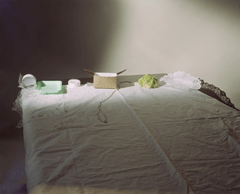Exhibition information
Laura Letinsky
Before the colors deepened and grew small
Before the colors deepened and grew small
From 5 September to 15 November 2008, Galerie m Bochum is showing for the first time photographic still lifes from Laura Letinsky’s series “Hardly More Than Ever” (1997-2006) and “To Say It Isn’t So” (2006/07). The Canadian artist was born in 1962 and nowadays lives in Chicago.
Laura Letinsky began to take pictures of the remains of meals using her 4 x 5” camera for the first time in Berlin, in 1997. These feature items such as dirty dishes, empty packages or fruit peels. Letinsky has since developed her own pictorial aesthetic in her still lifes, one based on a painterly quality that expresses a special kind of languid beauty. Gentle color gradients reflect subtle lighting conditions and contrast with sculptural objects that stand out starkly from their surroundings, seeming to take on a life of their own. These still lifes evince a contemporary approach to the world of things, leading to pictures in which symbolism no longer plays the prominent role it once did in 16th-century Dutch and Flemish still life painting – a tradition echoed by the formal qualities of Letinsky’s photographs.
The obvious staging of the objects as well as the concealment of any point of spatial reference repeatedly challenge our faculties of perception anew. Letinsky keeps viewers guessing by utilizing the laws of perspective. Tabletops frequently take on the look of whole landscapes leading off into infinity, or they might give more of a flat, two-dimensional impression, with objects seeming about to slide off. Some works even negate any spatial reference, the things shown appearing to be suspended in an indeterminate space. The carefully chosen and arranged objects might stand out from an almost monochrome background like precious treasures. Or they almost disappear with their light or neutral colors, calling for a keen gaze to make them out in the picture space.
The still, almost nostalgic beauty of the ensembles of opened presents, cookie crumbs or empty candy wrappers arouse in us a sense of longing. Running through this work is a lyricism evoked by the irretrievable loss of a momentary situation, a sense of the transience of life’s pleasures on the edge of banality.
"The title Hardly More Than Ever is a play on words, either lifted or inspired by Gertrude Stein's Tender Buttons, and other writing. I love the way she dislodges language from it's expected usage and exploits it's sound and association as revelation (revealing and uplifting). It's associated with phrases like 'I love you more than ever', yet the qualifier 'hardly' could go both ways, i. e. a little more than ever or 'hardly' as in 'barely', or 'not as much'.
For To Say It Isn't So, I have similar associations. 'To say it, isn't so' with a comma separating the clauses would mean that to say something, doesn't make it so (something I tell my 10 year old son all the time although if one knows their language theory, particularly the notion of the performative utterance, to say something can make it so).
A lot of this is suggestive and playing with language in the way that I hope my work ‘play’ with photography (photography as visual ‘language’)."
Laura Letinsky began to take pictures of the remains of meals using her 4 x 5” camera for the first time in Berlin, in 1997. These feature items such as dirty dishes, empty packages or fruit peels. Letinsky has since developed her own pictorial aesthetic in her still lifes, one based on a painterly quality that expresses a special kind of languid beauty. Gentle color gradients reflect subtle lighting conditions and contrast with sculptural objects that stand out starkly from their surroundings, seeming to take on a life of their own. These still lifes evince a contemporary approach to the world of things, leading to pictures in which symbolism no longer plays the prominent role it once did in 16th-century Dutch and Flemish still life painting – a tradition echoed by the formal qualities of Letinsky’s photographs.
The obvious staging of the objects as well as the concealment of any point of spatial reference repeatedly challenge our faculties of perception anew. Letinsky keeps viewers guessing by utilizing the laws of perspective. Tabletops frequently take on the look of whole landscapes leading off into infinity, or they might give more of a flat, two-dimensional impression, with objects seeming about to slide off. Some works even negate any spatial reference, the things shown appearing to be suspended in an indeterminate space. The carefully chosen and arranged objects might stand out from an almost monochrome background like precious treasures. Or they almost disappear with their light or neutral colors, calling for a keen gaze to make them out in the picture space.
The still, almost nostalgic beauty of the ensembles of opened presents, cookie crumbs or empty candy wrappers arouse in us a sense of longing. Running through this work is a lyricism evoked by the irretrievable loss of a momentary situation, a sense of the transience of life’s pleasures on the edge of banality.
"The title Hardly More Than Ever is a play on words, either lifted or inspired by Gertrude Stein's Tender Buttons, and other writing. I love the way she dislodges language from it's expected usage and exploits it's sound and association as revelation (revealing and uplifting). It's associated with phrases like 'I love you more than ever', yet the qualifier 'hardly' could go both ways, i. e. a little more than ever or 'hardly' as in 'barely', or 'not as much'.
For To Say It Isn't So, I have similar associations. 'To say it, isn't so' with a comma separating the clauses would mean that to say something, doesn't make it so (something I tell my 10 year old son all the time although if one knows their language theory, particularly the notion of the performative utterance, to say something can make it so).
A lot of this is suggestive and playing with language in the way that I hope my work ‘play’ with photography (photography as visual ‘language’)."



